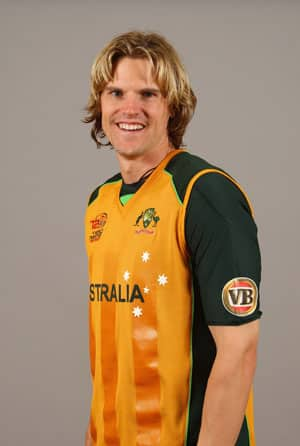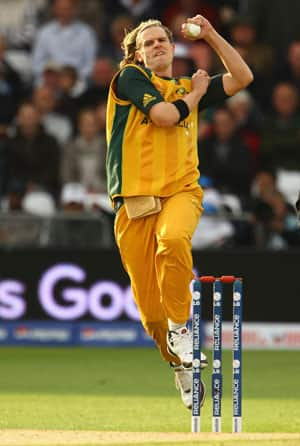
Nathan Bracken © Getty Images
Nathan Bracken, born on September 12, 1977, was an effective one-day bowler for Australia who formed a crucial part of their successful limited overs unit in the 2000s. He also stood for elections in 2013. Nishad Pai Vaidya profiles the left-arm seamer’s career.
Nathan Bracken was one of the most accurate and nagging bowlers in the Australian setup. He may not have had the pace of a Brett Lee, but the left-armer’s subtle variations and swing made it difficult for opposing batsmen in one-day cricket. Although, he did not shine in his limited opportunities in the whites, he did make a name for himself in the One-Day International (ODI) arena and was a part of two World Cup winnings sides.
Born on September 12, 1977, Bracken played for the New South Wales Colts and Australia Under-19s early in his career. In 1998, he made his First-Class debut during a Sheffield Shield encounter between Queensland and New South Wales (NSW). Over the next few years, he took time to establish himself in the domestic circuit. During the 2000-01 season, he put in some consistent performances for NSW and was rewarded with a call-up for the tri-series featuring West Indies and Zimbabwe. On debut against West Indies at the Melbourne Cricket Ground (MCG), he impressed with a spell of one for 30 and shared the new ball with Glenn McGrath.
Bracken played five games on in that tournament and was steady throughout. That won him a call-up for the tour to India in 2001, where he featured in four ODIs. He carried that form into this tour and impressed with his sound bowling skills. In a game at Visakhapatnam, he bowled seven overs and conceded only 21 runs to take two wickets — which truly showcased his potential. With Australia heading to England for the Ashes later that year, Bracken was picked on his good form. However, an injury put paid to his hopes of playing his first Ashes and he had to leave the tour before he had the opportunity to don the baggy green. It meant that he had to wait for almost 18 months to represent Australia again as he recovered and picked up his form on the sidelines.
Bracken forced his way back into the one-day side just before the 2003 World Cup when Australia hosted Sri Lanka and England for an ODI tri-series. On his comeback against England, he bowled a spell of three for 21 to bundle England out for 152 and also took the Man-of-the-Match award. Bracken also impressed with another good outing in the next ODI against Sri Lanka. However, the presence of McGrath, Jason Gillespie, Lee and Andy Bichel meant that there wasn’t room for him in the World Cup squad. Yet, when Gillespie picked up an injury during the tournament, Bracken was flown in as a replacement. He didn’t get a chance to play a game, but was a part of the side that steamrolled their opposition and comprehensively lifted the trophy that year.

Nathan Bracken played 116 ODIs for Australia and took 174 wickets at an average of 24.36. He took two five-wicket hauls © Getty Images
It was only in India in late 2003, that Bracken established himself in the absence of McGrath. Being the opening bowler, he consistently delivered with crucial spells upfront. He ended up taking 14 wickets in eight games as Australia won the tri-series, which also involved New Zealand. That pushed him closer to a Test berth and was handed the honour when they faced India at Brisbane in December 2003. In three Tests in that series, he could only take six wickets as the Indians were inspired that summer and gave Australia a stern fight to draw the four-match series 1-1. For Bracken, things got worse when he picked up an injury which ruled him out of the first game of the ODI tri-series that followed. From there on, his wait only got longer.
The 2004-05 season was one that heralded a change for Bracken. In a Sheffield Shield encounter against South Australia, his spell of seven for four bundled out the opposition for only 29 runs. Later, during the final, he delivered a spell of six for 27 to setup a platform for a NSW victory. These performances were strong enough to merit a call-up. He played for Australia A in September 2005 and was chosen for the games against the International Cricket Council (ICC) World XI. He did play two more Tests, albeit without much success, but continued being a part of the one-day side.
In 2006, Bracken had all but established himself in the one-day side and formed a perfect foil to Lee and McGrath. His left-armers added dimension to the attack. Over the next two years, bracken was a part of phenomenally successful one-day unit. In 2006, he got his first international fifer in the famous Johannesburg ODI. While his figures of five for 67 may be on the more expensive side, when you consider the carnage on the day, they are highly respectable.
The consistency continued and he kept getting the early breakthroughs. Here is a look at his record in one-day cricket in each year:
| Year |
M |
W |
Ave |
| 2001 |
9 |
10 |
30.30 |
| 2003 |
8 |
18 |
13.83 |
| 2005 |
6 |
7 |
35.00 |
| 2006 |
23 |
46 |
18.82 |
| 2007 |
28 |
36 |
28.11 |
| 2008 |
18 |
31 |
18.16 |
| 2009 |
24 |
26 |
38.53 |
One can see how effective he was since 2006 and it pushed him to the summit of the ODI bowlers’ rankings in 2008 and early 2009. To average under 20 in two calendar years in ODIs is simply a phenomenal achievement and highlights his value to that strong Australian team. During the ODI tri-series against India and Sri Lanka in 2008, he was adjudged as the Man-of-the-Series as he ended as the leading wicket-taker. At the annual Australian awards, he was named the ODI Player of the year in 2009. Sadly, he picked up a knee injury and was forced out of the reckoning. He battled hard, but couldn’t get back in to the Australian side and called it a day in 2011.
Post retirement, he has made appearances as an expert in a few games. He is also involved in a legal battle against Cricket Australia (CA) as he feels they did not take the proper measures to help him recover from the knee injury. Recently, he also threw his hat in the ring to stand for an election (independently) from Dobell in Australia.
He may not have been the most flamboyant of players, but was very effective. Here is a cursory glance at his record in ODIs:
| M |
W |
Ave |
BBI |
SR |
5WI |
4WI |
| 116 |
174 |
24.36 |
5/ 47 |
33.0 |
2 |
5 |
(Nishad Pai Vaidya is a Correspondent with CricketCountry and anchor for the site’s YouTube Channel. His Twitter handle is @nishad_44)


























